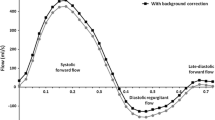Abstract
To investigate the effect of breath-holding on left-to-right shunts in patients with a secundum atrial septal defect (ASD). Thirty-five consecutive patients with secundum ASDs underwent right heart catheterization and invasive oximetry. Phase-contrast magnetic resonance imaging (MRI) was performed for the main pulmonary artery and ascending aorta. All measurements were obtained during free breathing (FB) (quiet breathing; no breath-hold), expiratory breath-hold (EBH), and inspiratory breath-hold (IBH). Pulmonary circulation flow (Qp) and systemic circulation flow (Qs) were calculated by multiplying the heart rate by the stroke volume. Measurements during FB, EBH, and IBH were compared, and the differences compared to invasive oximetry were evaluated. There were significant differences among the measurements during FB, EBH, and IBH for Qp (FB, 7.70 ± 2.68; EBH, 7.18 ± 2.34; IBH, 6.88 ± 2.51 l/min); however, no significant difference was found for Qs (FB, 3.44 ± 0.74; EBH, 3.40 ± 0.83; IBH, 3.40 ± 0.86 l/min). There were significant differences among the measurements during FB, EBH, and IBH for Qp/Qs (FB, 2.38 ± 1.12; EBH, 2.24 ± 0.95; IBH, 2.14 ± 0.97). Qp/Qs during FB and EBH correlated better with Qp/Qs measured by invasive oximetry than did IBH. The limit of agreement was smaller for EBH than for FB and IBH. In patients with secundum ASDs, Qp/Qs significantly decreased with breath-holding. The accuracy of the Qp/Qs measurement by MRI compared with invasive oximetry during EBH was higher than during FB and IBH.







Similar content being viewed by others
References
Hoffman JI, Kaplan S, Liberthson RR (2004) Prevalence of congenital heart disease. Am Heart J 147:425–439
Silvestry FE, Cohen MS, Armsby LB et al (2015) Guidelines for the echocardiographic assessment of atrial septal defect and patent foramen ovale: from the American Society of Echocardiography and Society for Cardiac Angiography and Interventions. J Am Soc Echocardiogr 28:910–958
Kuijpers JM, Mulder BJ, Bouma BJ (2015) Secundum atrial septal defect in adults: a practical review and recent developments. Neth Heart J 23:205–211
Debl K, Djavidani B, Buchner S et al (2009) Quantification of left-to-right shunting in adult congenital heart disease: phase-contrast cine MRI compared with invasive oximetry. Br J Radiol 82:386–391
Beerbaum P, Korperich H, Barth P, Esdorn H, Gieseke J, Meyer H (2001) Noninvasive quantification of left-to-right shunt in pediatric patients: phase-contrast cine magnetic resonance imaging compared with invasive oximetry. Circulation 103:2476–2482
Brenner LD, Caputo GR, Mostbeck G et al (1992) Quantification of left to right atrial shunts with velocity-encoded cine nuclear magnetic resonance imaging. J Am Coll Cardiol 20:1246–1250
Hundley WG, Li HF, Lange RA et al (1995) Assessment of left-to-right intracardiac shunting by velocity-encoded, phase-difference magnetic resonance imaging. A comparison with oximetric and indicator dilution techniques. Circulation 91:2955–2960
Ley S, Ley-Zaporozhan J, Kreitner KF et al (2007) MR flow measurements for assessment of the pulmonary, systemic and bronchosystemic circulation: impact of different ECG gating methods and breathing schema. Eur J Radiol 61:124–129
Sakuma H, Kawada N, Kubo H et al (2001) Effect of breath holding on blood flow measurement using fast velocity encoded cine MRI. Magn Reson Med 45:346–348
Beerbaum P, Korperich H, Gieseke J, Barth P, Peuster M, Meyer H (2003) Rapid left-to-right shunt quantification in children by phase-contrast magnetic resonance imaging combined with sensitivity encoding (SENSE). Circulation 108:1355–1361
Ley S, Fink C, Puderbach M et al (2006) MRI Measurement of the hemodynamics of the pulmonary and systemic arterial circulation: influence of breathing maneuvers. AJR Am J Roentgenol 187:439–444
Johansson B, Babu-Narayan SV, Kilner PJ (2009) The effects of breath-holding on pulmonary regurgitation measured by cardiovascular magnetic resonance velocity mapping. J Cardiovasc Magn Reson 11:1
Walker PG, Cranney GB, Scheidegger MB, Waseleski G, Pohost GM, Yoganathan AP (1993) Semiautomated method for noise reduction and background phase error correction in MR phase velocity data. J Magn Reson Imaging 3:521–530
Baim DS, Grossman W (2006) Grossman’s cardiac catheterization, angiography, and intervention, 7th edn. Lippincott Williams & Wilkins, Philadelphia
Du ZD, Hijazi ZM, Kleinman CS, Silverman NH, Larntz K (2002) Comparison between transcatheter and surgical closure of secundum atrial septal defect in children and adults: results of a multicenter nonrandomized trial. J Am Coll Cardiol 39:1836–1844
Ferrigno M, Hickey DD, Liner MH, Lundgren CE (1986) Cardiac performance in humans during breath holding. J Appl Physiol 60:1871–1877
Porth CJ, Bamrah VS, Tristani FE, Smith JJ (1984) The Valsalva maneuver: mechanisms and clinical implications. Heart Lung 13:507–518
Tsai LM, Chen JH (1990) Abnormal hemodynamic response to Valsalva maneuver in patients with atrial septal defect evaluated by Doppler echocardiography. Chest 98:1175–1178
Virolainen J, Ventila M, Turto H, Kupari M (1995) Influence of negative intrathoracic pressure on right atrial and systemic venous dynamics. Eur Heart J 16:1293–1299
Chaturvedi A, Hamilton-Craig C, Cawley PJ, Mitsumori LM, Otto CM, Maki JH (2016) Quantitating aortic regurgitation by cardiovascular magnetic resonance: significant variations due to slice location and breath holding. Eur Radiol 26:3180–3189
Acknowledgements
This work was supported by the Japan Society for the Promotion of Science (JSPS), KAKENHI (15H06478).
Author information
Authors and Affiliations
Corresponding author
Ethics declarations
Conflict of interest
S. Kawanami: Bayer Healthcare Japan, Modest, Research Grant; Philips Electronics Japan, Modest, Research Grant. Other authors: None.
Ethics approval
The study was approved by our institutional review board.
Informed consent
Written informed consent was obtained from each patient prior to imaging.
Appendix
Appendix
See Fig. 8.
Rights and permissions
About this article
Cite this article
Yamasaki, Y., Kawanami, S., Kamitani, T. et al. Noninvasive quantification of left-to-right shunt by phase contrast magnetic resonance imaging in secundum atrial septal defect: the effects of breath holding and comparison with invasive oximetry. Int J Cardiovasc Imaging 34, 931–937 (2018). https://doi.org/10.1007/s10554-018-1297-1
Received:
Accepted:
Published:
Issue Date:
DOI: https://doi.org/10.1007/s10554-018-1297-1





